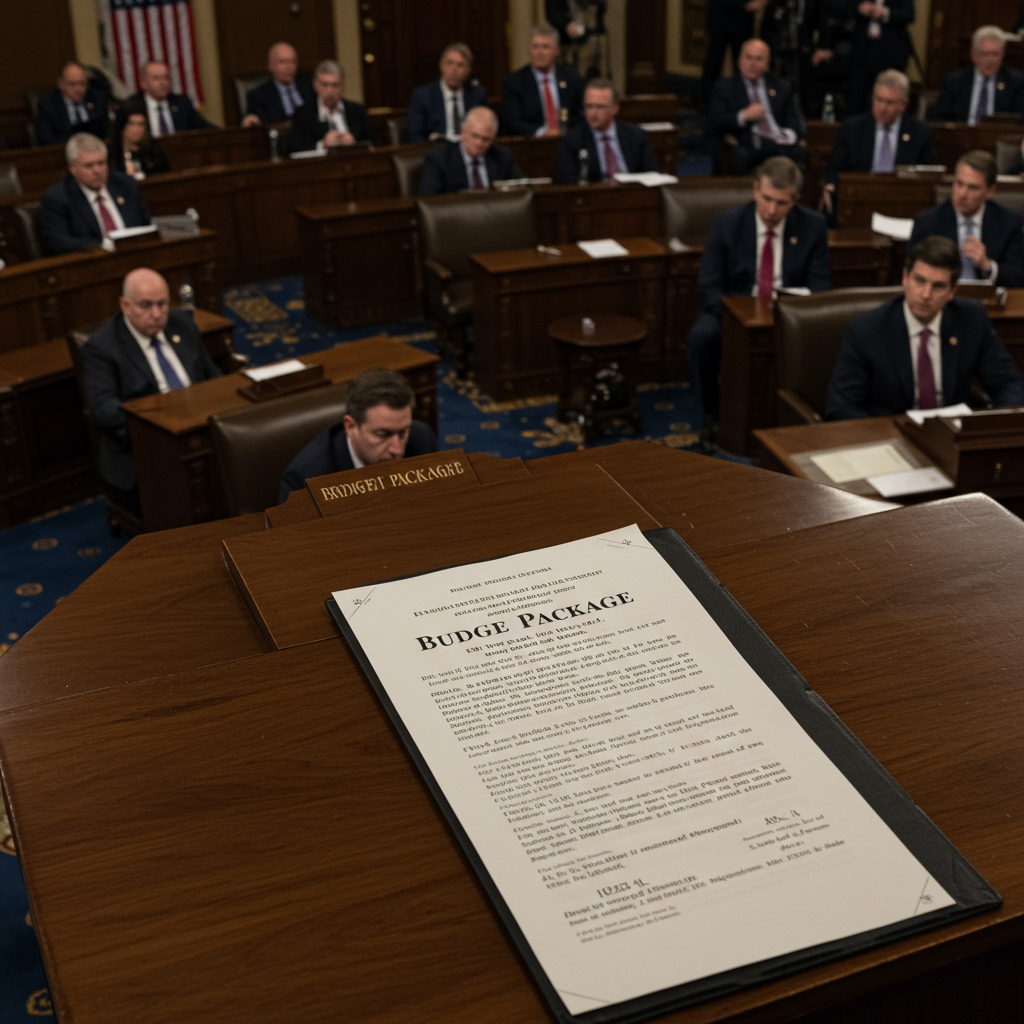The fate of a sweeping tax and spending package central to President Donald Trump’s second-term agenda hangs in the balance. Republicans in the U.S. senate have managed a narrow procedural victory, advancing the legislation toward a potential final vote despite significant internal party divisions and unified Democratic opposition. This crucial step occurred just ahead of a self-imposed July 4th deadline, highlighting the urgency Republicans attach to passing the measure.
Senate Advances Trump’s “Big Beautiful Bill” Amidst Dissent
The procedural vote to open debate on the latest text of the bill saw a 51-49 result, largely along party lines. This outcome represents a key initial hurdle Republicans scrambled to clear. However, the slim margin underscored the challenges facing party leaders. Two Republican senators ultimately sided with Democrats in opposing the move to take up the extensive bill.
Party leadership actively lobbied members for support leading up to the Saturday vote. This effort followed the release of the bill’s updated text, spanning 940 pages, shortly after midnight. Vice-President JD Vance was even prepared to cast a tie-breaking vote if necessary. However, Republicans were able to secure just enough support through last-minute negotiations without needing his intervention for this initial step.
Republican Disagreements on Spending and Tax Cuts
A major point of contention within the Republican caucus revolves around the balance between cutting welfare programs and extending a substantial $3.8 trillion in Trump-era tax breaks. Divisions over specific provisions have made securing a unified front challenging. Leaders worked to craft revisions aimed at appeasing various factions, including backbench holdouts.
Despite the internal disagreements, some Republicans who had previously expressed skepticism were persuaded to support advancing the bill. This group included centrist Senators Lisa Murkowski of Alaska and Susan Collins of Maine. Senator Ron Johnson of Wisconsin initially voted no but changed his vote to yes before the session concluded.
What’s Inside the Sprawling Legislation?
Dubbed the “Big Beautiful Bill” by President Trump, the measure is a comprehensive package addressing numerous Republican priorities. At its core, it seeks to make permanent many individual and business tax cuts enacted in 2017 that are set to expire by the end of 2025. The bill also includes new tax cuts championed by Trump during his campaign. These include provisions for a tax deduction on Social Security benefits and the elimination of taxes on overtime pay and tips.
The bill allocates significant funding, reportedly $350 billion, towards national security, including border security measures. It also incorporates changes designed to address concerns raised by some moderate Republicans and senators from specific states. For instance, it includes increased funding for rural hospitals, aimed at mitigating concerns that the original proposal could negatively impact healthcare access in constituents’ areas.
Revisions were also made concerning the Supplemental Nutrition Assistance Program (SNAP). Notably, Alaska and Hawaii would receive a temporary exemption from a proposed requirement for states to share program costs. This followed advocacy from Alaska’s Republican senators, as the program is currently fully funded by the federal government.
Contentious Provisions Draw Heavy Criticism
Despite some concessions, the bill retains highly controversial elements. Significant restrictions and requirements on Medicaid, the vital healthcare program serving millions of elderly, disabled, and low-income Americans, remain in place. These provisions have drawn fierce opposition from Democrats and healthcare advocates.
Senator Patty Murray of Washington state described the proposed Medicaid changes as potentially representing “the largest healthcare cuts in history.” Analysis from the nonpartisan Congressional Budget Office (CBO) on a previous version of the bill projected dire consequences. The CBO estimated that approximately 7.8 million people could lose health insurance coverage due to such Medicaid reductions. Separately, analysis on the House-passed version projected roughly 3 million fewer people would qualify for food aid.
The bill also faces criticism from outside traditional political circles. Prominent billionaire Elon Musk publicly denounced the Senate draft on social media platform X. He argued that proposed taxes targeting solar and wind energy projects are damaging. Musk claimed the legislation would “destroy millions of jobs in America and cause immense strategic harms to our country.” He added that it provides “handouts to industries of the past while severely damaging industries of the future,” calling it “utterly insane and destructive.”
Beyond program cuts and energy taxes, critics point to the bill’s potential impact on the national debt. Nonpartisan groups estimate a version of the bill could add trillions to the already substantial US debt, which currently exceeds $36 trillion. Furthermore, analyses suggest the tax cut provisions disproportionately benefit wealthier individuals and corporations. The CBO analysis of the House version indicated top earners could see significant tax cuts while the lowest-income households could see a loss of resources.
Path to Passage Remains Uncertain
The bill now needs a simple majority to clear the Senate floor and head to the House for reconciliation of differences. With Republicans holding 53 seats in the 100-member chamber, they can afford only three defections, plus the potential tie-breaking vote from the Vice-President.
Democrats have signaled their intention to delay the process. Senate Minority Leader Chuck Schumer stated his party would force Republicans to read the nearly 1,000 pages of the bill aloud before debate can formally begin. This tactic aims to draw attention to the bill’s contents and slow its progress.
The White House has strongly pushed for the bill’s passage. A memo reportedly sent to Senate offices endorsed the latest revisions and urged swift approval. The memo warned that failure to pass the budget “would be the ultimate betrayal,” according to reports. President Trump himself took to Truth Social to publicly criticize Senator Thom Tillis for opposing the procedural vote, even suggesting he would meet with potential primary challengers.
The bill’s fate remains uncertain as Republican senators continue to negotiate and express reservations over specific provisions. The combination of internal dissent and unified Democratic opposition means the final vote will be closely watched and could still fail despite clearing the initial hurdle. The use of the reconciliation process, which bypasses the usual 60-vote threshold needed to overcome a filibuster, is critical for the bill’s chances. However, even under reconciliation rules, a simple majority is required, leaving little room for error for Republican leadership.
Frequently Asked Questions
What is the “Big Beautiful Bill” and what are its main goals?
The “Big Beautiful Bill” is a major tax and spending package championed by President Trump. Its primary goals include making permanent the 2017 Republican tax cuts, set to expire soon, and adding new tax breaks like eliminating taxes on tips and overtime. It also aims to fund priorities like border security and national defense while implementing significant spending reductions, notably targeting social programs like Medicaid and potentially welfare programs.
What are some specific controversial provisions in the bill?
Among the most controversial elements are proposed restrictions and requirements on Medicaid, which critics and CBO estimates suggest could cause millions to lose healthcare coverage. There are also concerns about proposed taxes on renewable energy projects, which critics like Elon Musk argue could harm job growth and future industries. The bill’s overall impact on the national debt and its potential to disproportionately benefit wealthy taxpayers while cutting programs for low-income individuals are also significant points of contention.
What is the current status of the bill in the Senate and what challenges does it face?
The bill recently cleared a key procedural hurdle in the Senate with a narrow 51-49 vote to open debate. However, it still needs a simple majority (51 votes) to pass the Senate floor. It faces significant challenges, including ongoing dissent from some Republican senators who oppose certain provisions, such as those related to spending cuts or energy taxes. Democrats are united in opposition and are employing tactics to delay the process. The bill must overcome these internal divisions and unified opposition to secure final passage.
The path forward for President Trump’s signature tax and spending bill remains precarious. While Senate Republicans cleared a critical procedural hurdle, the narrow margin and continued dissent within their ranks highlight the difficulty of securing final passage. With unified Democratic opposition and high-profile critics raising concerns about everything from healthcare cuts to energy policy and the national debt, the outcome of the final Senate vote is far from guaranteed. The legislative battle underscores the deep divisions in Washington over tax policy, government spending, and the future direction of the economy.
Word Count Check: 1073



